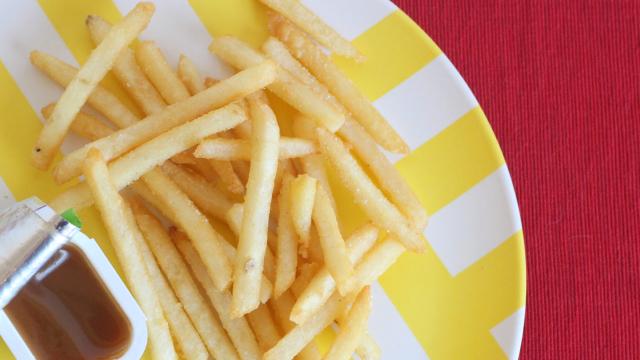In 1990, two significant things happened: I had a dinosaur-themed birthday party, and McDonald’s changed their french fry recipe. One might argue that someone who was four in 1990 couldn’t possibly remember the iconic flavour of the original McDonald’s fry, but I remember my dinosaur-themed birthday party in extreme detail, so checkmate, Aristotle.
[referenced url=”https://www.lifehacker.com.au/2019/02/how-to-make-restaurant-worthy-chips/” thumb=”https://i.kinja-img.com/gawker-media/image/upload/t_ku-large/dhtc0hvhmwmy3n29ibld.jpg” title=”How To Make Restaurant-Worthy Chips” excerpt=”When it comes to chips, fast food establishments do it best. It’s not that they use the freshest potatoes (they don’t), or that they have some secret seasoning (it’s salt), or even the fact that they deep fry (it’s a good tactic, but not necessary). The secret, my friends, is that they’re double cooked.”]
The company’s switch from beef tallow to vegetable oil upset many people, including Malcom Gladwell and my father, and their anger was not without merit. Cooking oil isn’t just a conduit for heat; it flavours the chip, and the beefy flavour and super-crunchy exterior that tallow imparted was deeply missed by french-fried-potato enthusiasts. If duck fat can make your fries taste like they came from a pretentious bistro, beef tallow is the key to capturing that retro fast food magic.
Just like McDonald’s before us, we will be using frozen fries. As we have discussed before, a once-cooked fry is a big crime, and frozen fries are frankly a very good product (get the skinny “fast food style” kind). Cooking a stick of potato once leads to soggy, soft fries; a second round of cooking—this time in tallow—is needed to properly crisp it up.
But the fat is not enough. Seasoning is also key to the 1980s fry experience. Like popcorn, fries are best when they are dusted in super-fine, nearly pulverized salt. Also worth noting: while today’s McDonald’s fries do not contain MSG, they do contain hydrolyzed vegetable protein, which is widely used in the food industry for its glutamate content. If you wish to go full fast food, you can get the HVP effect by pulverizing MSG right along with your salt.
Honestly, you should pulverize all MSG you plan to use as a finishing salt, as MSG crystals are long, thin rods, do not come out of shakers with ease, and look kinda weird just sitting on top of food. (I could not confirm the pre-1990 fries also contained HVP, so feel free to omit if this is not how you remember them.)
To create a truly happy meal, even if that meal is nothing more than a pile of fries, you will need:
-
1/4 cup of beef tallow, plus more as needed
-
As many fries as you like
-
2 tablespoons fine sea salt
-
1 tablespoon MSG (optional)
Combine salt and MSG in a food processor or spice grinder and pulse to combine. Christen it “umami salt” and set aside. Heat the fat over medium-high heat in a large stainless steel or cast iron pan. Once it starts to shimmer a little, place a single test fry in the oil. If it immediately begins to sizzle, place as many fries as you can fit in a single layer in the pan. (If not, let the fat heat a little longer before adding the rest of your fries.)
Let the fries sizzle and cook, gently swirling and flipping them with a spatula or tongs in the hot tallow until they are a pale golden brown and crispy—this should take 6-8 minutes. Remove them from the beef fat with tongs or a slotted spatula, place them on paper towels to drain.
Season with umami salt, and serve immediately with McDonald’s Sweet & Sour sauce, which is actually the best fry dipping sauce in existence, and cannot be replicated by God nor human. (Speaking of, I need to replenish my stash.)

Leave a Reply
You must be logged in to post a comment.